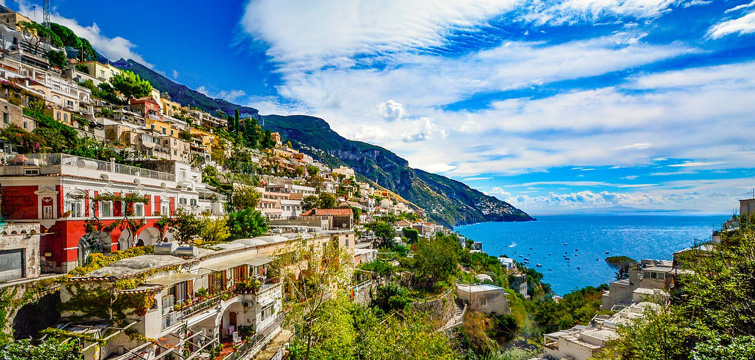Positano and Amalfi
The Amalfi and Positano tour will start by visiting one of the most famous tourist itineraries in Italy, thanks to the exceptional beauty of the landscapes that follow one another incessantly in a setting of rocks, picturesque towns, lush vegetation and the enchanting blue sea background. You will then admire Positano, Praiano and Amalfi where you can visit the splendid Duomo, lunch in a restaurant (optional). In the afternoon continue to Sorrento, one of the most famous tourist resorts in Italy for the production of oranges, lemons and fine wines. Free time for shopping. Return in the evening.
On the Amalfi and Positano tours you will be picked up directly from your hotel at the scheduled time to visit the following stages:
- Visit Positano.
- Amalfi tour.
- Lunch in Amalfi at a typical restaurant.
- Tour of the major monuments of Sorrento.
In the evening you will be driven back to your hotel. The total duration of the tour will be around 10 hours.
What see
Positano
Positano is a holiday resort, thanks to its location where the climate is very mild, subtropical, the winters are very warm with temperatures that never fall below 8 degrees, long and hot summers but cooled by the sea breeze.
Positano has been a holiday resort since the Roman Empire. In fact, beneath the church of Santa Maria Assunta there was a finding of a villa whose access was by sea. From the 10th century to the 12th century Positano was part of the Duchy of Amalfi. In particular, the town is renowned in the 10th century as a commercial center developed so as to compete with the renowned Venice.
Saracen Towers
In the Middle Ages Positano saw the construction of numerous towers for the sighting of the Saracens (peoples coming from the Arabian peninsula), authors of raids and raids against the local population. The first tower is located outside the town of Positano in Punta Campanella where the Amalfi coast ends and the Sorrentine coast begins. From the first tower sighted the Arabs launched a first signal with a cannon shot, alerted the second tower and so on, warning the whole Amalfi coast so that the Positanesi could take refuge on the steep hills. Today Positano is a tourist center famous throughout the world and does not fear rivals.
Amalfi
Amalfi is an Italian town in the province of Salerno and since 1997, the Amalfi coast takes its name from Amalfi, declared by the UNESCU HERITAGE OF HUMANITY.
Its foundation is traced back to the Romans (its coat of arms bears the inscription Descendit ex patribus romanorum). From the ninth century, first (in chronological order) among the maritime republics, it competed with Pisa, Venice and Genoa to control the Mediterranean Sea. The Maritime Code of Amalfi, better known as the Tavole amalfitane, had a great influence until the XVII century. Amalfi reached its maximum splendor in the XI century, after which it began a rapid decline: in 1131 it was conquered by the Normans and in 1135 and 1137 sacked by the Pisans. In 1343, then, a storm with a subsequent tsunami destroyed most of the city.
The most famous monument of Amalfi is certainly the Duomo in Arab-Sicilian style and currently dedicated to Sant’Andrea, patron saint of the city. In fact, more than the Duomo one should speak of the Cathedral complex, since the current building results from overlapping and juxtaposing various churches of various ages. The first building dedicated to Christian worship, was an early Christian church dating back to the 6th century AD, which, as in many similar cases throughout Italy, probably replaced a temple dedicated to Roman gods. Between the 6th and 9th centuries AD, the first Cathedral built on the previous Paleochristian, was dedicated to the Most Holy Mary of the Assumption, the first protector of Amalfi. The current church dedicated to Sant ‘Andrea dates back to the 9th century AD, it was built alongside the previous one and communicating with it, commissioned by the Duke Mansone I; later additions were made to it in the Middle Ages and the Baroque period (see the Campanile, the altar of Sant’Andrea, with two statues by Bernini; the beautiful Cloister of Paradise, erected by the bishop Filippo Augustariccio and where there was the sarcophagus he represented to high relief “the wedding of Peleus and Thetis” on the lateral surface and “Romulus and Remus suckled by the wolf” to one of the chiefs, with the medieval inscription “Cesarius de Alaneo (Alagno) de Amalfi …. MCCLXIII”, “CESAREUS ALANEO IACET ARCHIDIACONUS ISTE IURIBUS.
Sorrento
Sorrento, the most beautiful and famous town on the peninsula is located about 50 km south of Naples and is located above a terrace overlooking the sea, the landscape of gardens and citrus fruits. Surrounded by equally pleasant and characteristic villages (Vico Equense, Meta, Piano di Sorrento).
The story speaks of a Greek “Surrentum” which would recall in the name the sirens then adored on the peninsula, and of the luxurious villas that the Romans built in the imperial age, imitating the predilection of Tiberius for the nearby Capri. The foundation of Sorrento is attributed to the Greeks, although the first inhabitants of the place were the Italic peoples from the Etruscans.
In the historic center you can see the orthogonal layout of the roads of Roman origin with thistles and decumans, while towards the mountain it is surrounded by sixteenth-century walls where you can visit the Cathedral rebuilt in the fifteenth century, and the Church of St. Francis of Assisi with its remarkable fourteenth-century cloister with an arched portico with intertwining arches on octagonal pillars. The Sedile Dominova and the Correale Museum of Terranova where paintings and objects from the 17th and 18th centuries are preserved.


